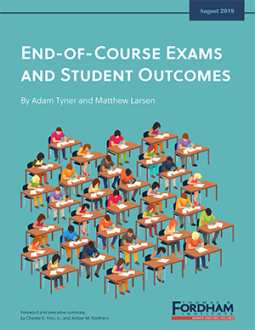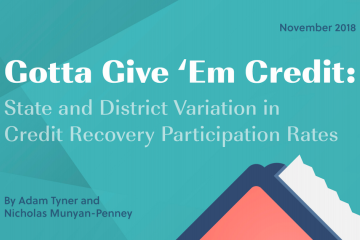Beginning in the late 1990s, many states took it upon themselves to institute end-of-course exams (EOCs) at the high school level, tests specifically designed to assess students’ mastery of the content that various subject-matter courses covered. But was this testing policy good for students?
End-of-Course Exams and Student Outcomes, co-authored by Fordham’s Adam Tyner and Matthew Larsen, an assistant professor of economics at Lafayette College, provides a rich longitudinal look at state policies related to EOCs over the past twenty years and the effects of administering EOCs in different subjects on high school graduation rates and college entrance exam scores.
The study yielded five findings:
- The use of EOCs increased dramatically starting in the late 1990s, but in the past few years has declined somewhat.
- EOCs have been most widely used in math and science courses, but their use in English courses has risen fastest in the past decade.
- Most states use EOCs for a mix of school and student accountability.
- Unlike exit exams, EOCs are generally positively correlated with high school graduation rates.
- When analyzing EOCs by subject area, there is no statistically significant correlation with college entrance exam scores, but students in states with the most EOCs appear to outperform other students on these exams.
The report includes three recommendations for state-level policymakers:
- Embrace EOCs to leverage the potential benefits associated with external assessments without encountering the concerns raised about exit exams.
- Consider building high school accountability systems around EOCs, given the suggestive evidence that they can help improve student outcomes.
- Use EOCs to encourage students to put more effort into their own studies, perhaps by linking them to graduation or including them in course grades or on report cards.
The use of high-quality, content-linked external assessments could help push our education system toward mastery rather than seat time—a coveted goal, especially among advocates of competency-based and personalized models. That’s unlikely to happen, however, in the absence of external measures that schools and employers can trust. Adroitly deployed, EOCs can play this role.
This report was made possible through the generous support of the Charles and Lynn Schusterman Family Foundation and our sister organization, the Thomas B. Fordham Foundation.





